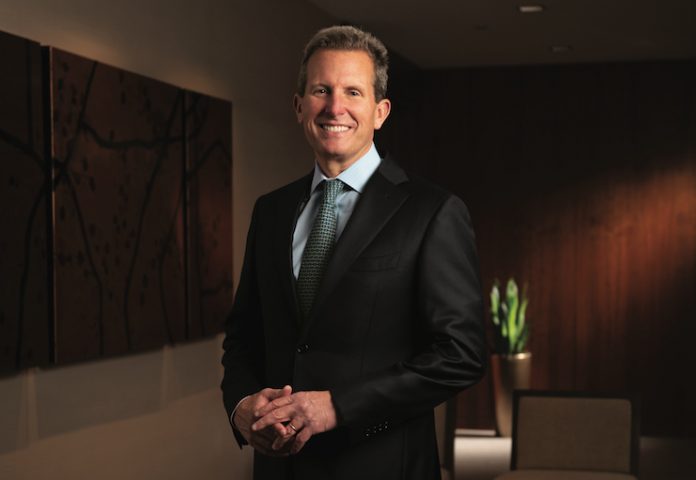Speaking with LODGING at the AAHOA annual meeting, Wyndham Hotels & Resorts CEO Geoff Ballotti discussed why the company’s economy and mid-segment properties continue to be a solid investment that developers can and do get behind. He also described the company’s highest-profile development initiatives—Women Own the Room and its 3-year, $40 million commitment to incentivize Microtel and La Quinta franchisees to conform to their respective prototypes.
What’s behind Wyndham’s announced plan to commit over $40 million to its Microtel and La Quinta brands?
Like everyone in the industry, we’re looking at any relief we can provide right now from a cost savings standpoint. The big-brand advisory councils and their economy-segment members wildly applauded the reduction of the “pandemic unfriendly” hot breakfast standard to coffee and a single breakfast item because it significantly cut costs by as much as 50 percent per occupied room. The ability to opt in to alternative housekeeping, too, also contributed further to the margin.
Yet, because Microtel is able to compete against midscale as well as economy properties, it punches above its weight in terms of profitability, with the highest RevPAR in its segment. That was one reason we believed it needed to maintain the hot breakfast standard, albeit on a reduced cost basis. It was also why we wanted to enable it to continue to improve and renovate, as when we introduced the La Quinta Del Sol prototype several years ago.
We are therefore launching a new prototype for Microtel, which is our fastest-growing economy brand right now from a new-construction standpoint. Although there is much talk about financing not being available, there’s actually plenty for the right brand, the right prototype, the right developer. Those who build a Microtel are investing in a brand that is consistent and is constantly evolving and improving.
Our investment of over $40 million over the next three years couples the new Microtel Lift Incentive Program with the successful LQUp Incentive Program for La Quinta to reflect La Quinta’s Del Sol design and Microtel’s new design-forward Moda prototype.
Together, these two programs help owners continue to raise the brands’ profiles while enhancing the guest experience and helping to achieve long-term success by offering forgivable note funding of up to $2,000 per room from Wyndham to supplement franchisees’ investment in hotel renovations that reflect elements of their respective brand’s prototypes.
What level of interest are you seeing among developers?
At this AAHOA meeting, more than 100 people attended our development meeting, suggesting that people are feeling good about the industry and what lies ahead.
Interest in our properties is high, at least partly because of how well the drive-to economy brands performed during the pandemic. We consider our economy brands, including Microtel, recession-proof, as fewer than 2 percent needed to close due to the pandemic.
Even before leisure started coming back, we were generally able to break even largely because of the makeup of 30 percent of our guests—which is people who never stop traveling, such as front-line workers, truckers, contractors, and sales reps on the road; and in the economy/midscale space, that’s enough to break even, or even create some level of profitability.
I am optimistic about leisure, where we continue to see growing demand despite the Delta variant, but having that base of everyday travelers is a significant selling point, as is having the number one loyalty program—in fact, 50 percent of check-ins say they want their Wyndham Rewards.
Why might an investor choose to build a Microtel now, while construction costs are elevated?
For people who have land, it’s a good time to build, especially since there are so few acquisition deals to be had. But our properties are easier, faster, and less expensive to build compared to other structures because they are lower rise, and right now, there is more lumber than steel.
Also, even though costs may be rising on the labor and materials front, the returns are still there: These hotels generate proven cash on cash returns in excess of 20 percent, which is why so many developers want to build them.
Finally, please describe Wyndham’s “Women Own the Room” program, which is said to “advance and empower female entrepreneurs who are interested in hotel ownership.”
Wyndham’s Women Own the Room program is intended to be a resource to help overcome common barriers women face in hotel development and to help them effectively open and run their hotels. It will include educational and networking events designed to introduce more women to the hotel industry, and use its balance sheet to support female owners in their efforts to secure financing through our network of debt and equity partners.
Wyndham is also launching a development incentive program that will provide meaningful Wyndham financing, plus complimentary or expanded first-year operating services, to support the success of hotels developed by women.
This is something we are all driving as a team. Even though there are plenty of women developers already, as a company, Wyndham strives to maintain a culture of diversity, equity, and inclusion across its organization. That we are committed to women’s advancement is also demonstrated in our support for programs such as AHLA’s ForWard, and that female representation is steadily increasing in our upper ranks—including one-third of our executive committee, where Michele Allen is CFO.
As the father of four girls, as well as CEO of a forward-thinking organization, I welcome the opportunity to see more women in our franchise development community.










